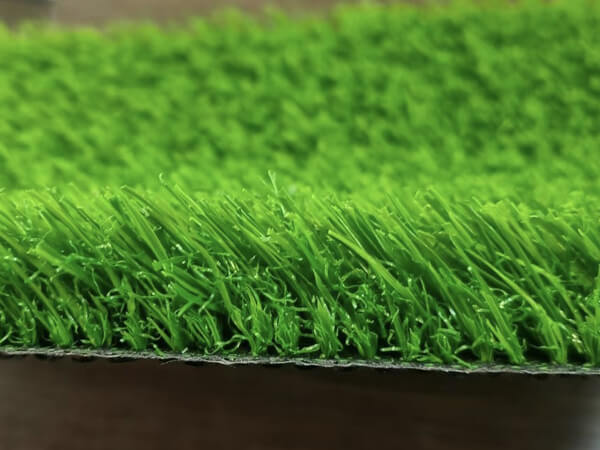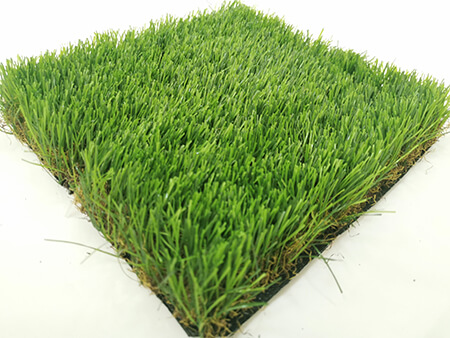
1. Introduction
Artificial lawns are a popular choice for their low maintenance and lasting appearance. However, like all products, they show signs of wear over time. Recognizing these aging signs helps you decide when it's time for a replacement. In this article, we’ll discuss the key signs that your artificial lawn is aging, from visual changes to performance and hygiene issues. Understanding these signs will help you maintain your lawn and extend its life.
![four colors Landscap Artificial grass for garden four colors Landscap Artificial grass for garden]()
2. Visual and Wear Signs of Aging
2.1 Flattened Fibers
One of the most common signs of aging in artificial grass is flattened fibers, particularly in high-traffic areas. The fibers
, which were once upright and vibrant, begin to mat over time. This reduction in uprightness diminishes the lawn’s ability to bounce back, making it look worn and lifeless. These flattened areas are often the first indicators that the turf has been subjected to extensive use.
The high foot traffic or even outdoor events such as parties or sports activities can accelerate this process. As more weight is applied to the fibers, the artificial grass loses its natural bounce-back ability. Once the fibers are matted down, it becomes difficult for them to stand upright again, even with brushing or cleaning.
Tip: To extend the life of your artificial lawn, consider regular brushing or the use of a power broom to lift matted fibers. This will help rejuvenate the fibers and keep the turf looking fresh for longer periods.
2.2 Fading and Discoloration
Exposure to UV rays is a significant factor in the aging of artificial grass. Over time, sunlight causes the vibrant green color to fade, leaving patches of dull, discolored turf. While some high-quality artificial lawns are equipped with UV-resistant technology, even the best options will eventually lose their color. This fading often starts in the areas that receive the most direct sunlight.
In regions with intense sun exposure or areas near pools where chlorine and other chemicals may be present, fading can occur more quickly. While the turf may still be functional, its visual appeal can significantly degrade, especially in areas where the color has faded unevenly.
Tip: Some artificial lawn suppliers, such as XiHY Turf, offer UV-resistant products that can significantly slow down the fading process. Opting for higher-quality turf may help preserve the vibrant color longer.
2.3 Tears and Fraying
Tears and fraying are telltale signs of aging that impact both the appearance and integrity of artificial turf. As the lawn ages, the seams where pieces of turf are joined together can come undone. Additionally, the edges may start to fray, exposing the underlying layers of the turf. These issues not only make the lawn look unkempt but also pose a tripping hazard.
Heavy use or improper installation techniques can also exacerbate this issue. If the seams start to come apart, it may allow dirt, debris, or even weeds to penetrate underneath the turf, further accelerating wear.
2.4 Exposed Infill or Underlayment
Over time, the fibers of artificial turf can separate, revealing the infill or underlayment. This can occur as the fibers lose their density or become damaged from wear and tear. The exposed layers can create a patchy look and may cause discomfort or safety issues if the turf no longer provides adequate coverage.
Additionally, in some cases, when the turf has been used for extended periods or subjected to poor maintenance, the underlying layers of the turf can become exposed, making the surface feel harder or uneven. This may impact the overall safety and comfort of the turf.
3. Functional and Performance Issues
3.1 Poor Drainage
An aging artificial lawn may struggle with drainage, leading to pooling water on the surface. Poor drainage often occurs as debris clogs the drainage holes or as the turf itself loses its ability to allow water to pass through effectively. This can create an environment conducive to mold and algae growth, further degrading the turf and potentially leading to unpleasant odors.
Additionally, as the lawn ages and becomes compacted, water may not flow as efficiently, leading to standing water that can harm the turf’s integrity and result in discoloration.
| Issue | Symptoms | Possible Solution |
| Poor Drainage | Pooling water, mold, algae growth | Regular cleaning, inspection of drainage holes, and clearing debris |
| Water Buildup | Water stagnation and turf damage | Ensure proper water flow and maintenance of drainage system |
3.2 Reduced Cushioning
One of the benefits of artificial grass is its cushioning, which makes it safer for activities like sports and play. Over time, the infill can compact, reducing the cushioning effect. As a result, the turf becomes harder and less comfortable to walk on, increasing the risk of injury. This issue is particularly concerning for high-use areas like playgrounds or sports fields.
Additionally, compacted turf can lead to uneven surfaces, where certain areas may feel harder than others, making the artificial lawn less safe for play.
4. Hygiene and Maintenance Challenges
4.1 Persistent Odors
Artificial turf can trap moisture, bacteria, and pet urine, leading to persistent odors. Over time, this can become a significant issue, especially if the turf is exposed to heavy use by pets or children. These smells may become difficult to remove with standard cleaning methods, signaling the need for deeper cleaning or replacement.
The trapped moisture can also cause bacteria or fungi to grow, exacerbating the odor problem. In extreme cases, the buildup of organic matter can result in a reduction in the turf's overall hygiene and safety.
4.2 Increased Maintenance Requirements
If your artificial lawn is requiring more frequent brushing, cleaning, or repairs, it's likely showing signs of aging. Older turf may not hold its shape as well and may require regular touch-ups to maintain its visual appeal. Increased maintenance often indicates that the turf’s original performance has diminished, and it may be time to consider a replacement.
Older artificial lawns might also need more frequent infill replacement, seam repairs, and stain treatments, as the turf’s structure deteriorates.
4.3 Weed Growth
While artificial turf is designed to prevent weed growth, an aging lawn with poor maintenance or insufficient infill can allow weeds to sprout through. This issue can be especially problematic in the areas where the turf has worn down the most. Weeds can compromise both the aesthetics and functionality of the lawn, requiring extra effort to control and remove.
Tip: Regularly inspect your turf for any signs of weed growth and address the issue immediately to avoid further damage. Weed barriers and proper infill can help prevent this from happening.
5. Signs Indicating It's Time for Turf Replacement
5.1 Fading and Loss of Color
Over time, artificial grass will begin to lose its vibrant green color. The UV rays, combined with environmental factors like dust and dirt, will gradually diminish the turf’s color. Once fading reaches a noticeable level, it can no longer replicate the fresh, lush appearance of a new lawn.
Fading can be especially noticeable in high-traffic areas, where the fibers may wear out faster than in more protected sections of the lawn.
5.2 Split or Damaged Fibers
As the turf ages, you may notice visible splits in the fibers. These splits are often caused by wear, improper maintenance, or extreme weather conditions. Split fibers reflect light in an unnatural way, making the lawn look dull and patchy. At this point, a turf replacement may be necessary to restore the lawn’s original appearance.
5.3 Seams Coming Apart
Another clear sign of aging is the separation of seams. Seams can come undone due to prolonged use, poor installation, or a lack of proper maintenance. This issue not only detracts from the appearance of the lawn but also poses a safety hazard. Uneven seams can cause tripping, especially in high-traffic areas.
5.4 Stains and Odors
Stubborn stains or persistent odors that cannot be removed despite cleaning efforts are significant signs that artificial turf has aged beyond its prime. These issues can occur when organic matter like pet waste or spilled liquids are not cleaned promptly. Over time, this can lead to mold and bacteria buildup, making the turf unpleasant and unsafe.
5.5 Drainage Issues
When the drainage system of artificial turf becomes clogged, it can lead to standing water. This not only affects the appearance of the lawn but can also contribute to mold growth and damage the turf’s structural integrity. Standing water can also encourage pests and other issues that require extensive repairs or turf replacement.
Conclusion
Artificial lawns provide a low-maintenance, long-lasting solution for both homeowners and businesses. However, over time, they show signs of aging such as fading, flattened fibers, and poor drainage. By recognizing these signs early, you can avoid costly repairs or replacements. Regular maintenance helps extend the life of your artificial lawn. XiHY offers high-quality artificial turf products designed to resist wear and retain their beauty, providing lasting value for your landscape.
FAQ
Q: What are the common aging signs of artificial lawn?
A: Common aging signs of artificial lawn include flattened fibers, fading or discoloration, tears or fraying, and poor drainage.
Q: Why does my artificial lawn fade over time?
A: Exposure to UV rays causes artificial lawn fibers to fade, leading to discoloration, especially in high-sun areas.
Q: How can I extend the life of my artificial lawn?
A: Regular maintenance, such as brushing and infill replacement, can help extend the life of your artificial lawn.
Q: Is poor drainage a sign of aging in artificial lawns?
A: Yes, poor drainage can develop as artificial lawns age, often due to debris clogging the drainage holes.
Q: How do I know when to replace my artificial lawn?
A: If you notice persistent stains, odors, or damaged fibers, it may be time to replace your artificial lawn.















